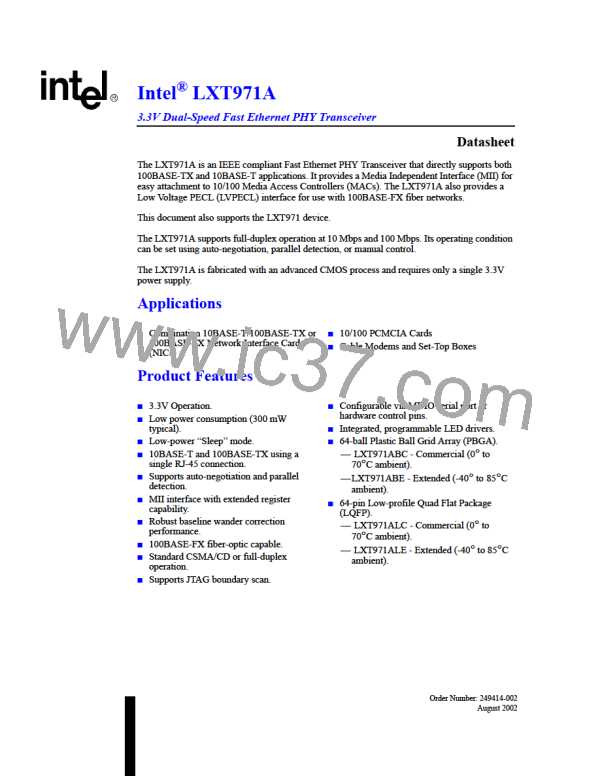LXT971A 3.3V Dual-Speed Fast Ethernet Transceiver
3.7.3.3.3 Programmable Slew Rate Control
The LXT971A device supports a slew rate mechanism whereby one of four pre-selected slew rates
can be used. This allows the designer to optimize the output waveform to match the characteristics
of the magnetics. The slew rate is determined by the TxSLEW pins as shown in Table 4 on
page 18.
3.7.3.4
Fiber PMD Sublayer
The LXT971A provides a Low Voltage PECL interface for connection to an external 3.3 V or 5.0 V
fiber-optic transceiver. (The external transceiver provides the PMD function for fiber media.) The
LXT971A uses an NRZI format for the fiber interface. The fiber interface operates at 100 Mbps
and does not support 10FL applications.
3.8
10 Mbps Operation
The LXT971A operates as a standard 10BASE-T transceiver. The LXT971A supports all the
standard 10 Mbps functions. During 10BASE-T operation, the LXT971A transmits and receives
Manchester-encoded data across the network link. When the MAC is not actively transmitting data,
the LXT971A drives link pulses onto the line.
In 10BASE-T mode, the polynomial scrambler/de-scrambler is inactive. Manchester-encoded
signals received from the network are decoded by the LXT971A and sent across the MII to the
MAC.
The LXT971A does not support fiber connections at 10 Mbps.
3.8.1
10BASE-T Preamble Handling
The LXT971A offers two options for preamble handling, selected by Register bit 16.5. In
10BASE-T Mode when 16.5 = 0, the LXT971A strips the entire preamble off of received packets.
CRS is asserted coincident with SFD. RX_DV is held Low for the duration of the preamble. When
RX_DV is asserted, the very first two nibbles driven by the LXT971A are the SFD “5D” hex
followed by the body of the packet.
In 10BASE-T mode with 16.5 = 1, the LXT971A passes the preamble through the MII and asserts
RX_DV and CRS simultaneously. In 10BASE-T loopback, the LXT971A loops back whatever the
MAC transmits to it, including the preamble.
3.8.2
3.8.3
10BASE-T Carrier Sense
For 10BASE-T links, CRS assertion is based on reception of valid preamble, and de-assertion on
reception of an end-of-frame (EOF) marker. Register bit 16.7 allows CRS de-assertion to be
synchronized with RX_DV de-assertion. Refer to Table 52 on page 81.
10BASE-T Dribble Bits
The LXT971A device handles dribbles bits in all modes. If one to four dribble bits are received, the
nibble is passed across the MII, padded with ones if necessary. If five to seven dribble bits are
received, the second nibble is not sent to the MII bus.
Datasheet
43
Document #: 249414
Revision #: 002
Rev. Date: August 7, 2002

 INTEL [ INTEL ]
INTEL [ INTEL ]